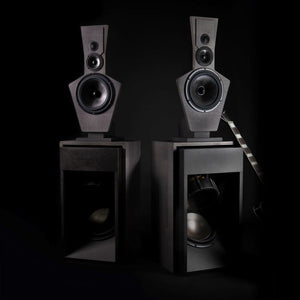Die Kunst und Evolution des Studiomonitorings
Mein Werdegang als Toningenieur
Von Frans de Rond, Ingenieur Sound Liaison
Als ich Anfang der 1990er-Jahre meine Karriere als Toningenieur begann, wurde mir ein klares Prinzip vermittelt: Ein Studiomonitor sollte den Klang nicht verfälschen. Er sollte Musik mit einem möglichst linearen und präzisen Frequenzgang wiedergeben. Die Idee war einfach: Wer auf einem neutralen System abmischt, dessen Aufnahmen klingen in jeder Wiedergabeumgebung gut.
Damals erfreuten sich aktive Studiomonitore zunehmender Beliebtheit. Sie waren kompakt, verfügten über eingebaute Verstärker und boten oft EQ-Einstellungen, um eine suboptimale Aufstellung auszugleichen, sei es auf Stativen hinter dem Mischpult oder sogar auf der Meterbrücke.
Die Genelec-Ära
Zu Beginn meiner beruflichen Laufbahn dominierten Genelec-Monitore die Studiolandschaft. Ihre unverwechselbaren, geschwungenen Gehäuse aus Aluminiumguss um Hoch- und Mitteltöner waren unverkennbar. Viele Toningenieure nutzten sie, und ich auch. Jahrelang arbeitete ich mit Genelec-Monitoren und sie leisteten mir gute Dienste.
Doch dann kam der Wendepunkt.
Die Welt des High-End-Audios entdecken
Ende der 90er-Jahre besuchte ich Rhapsody (ein High-End-Audiogeschäft) in Hilversum, um mir ein Paar „bessere“ HiFi-Lautsprecher für den privaten Musikgenuss zu kaufen. Dort lernte ich Harry van Dalen und Michael van Polen kennen. Harry, der Inhaber und leidenschaftliche Verfechter von High-End-Audio, stellte meine gesamte Überzeugung in Bezug auf Studiomonitoring infrage. Er argumentierte, dass die meisten Studiomonitore grundsätzlich nur bedingt in der Lage seien, Musik wirklich naturgetreu wiederzugeben.
Damals tat ich es ab. Ich hatte noch nie wirklich hochwertige Musik gehört und konnte daher nicht verstehen, was mir angeblich entging. Was man nicht kennt, vermisst man auch nicht (noch).
Jahre später war ich wieder bei Rhapsody, und diesmal hallten Harrys Worte in mir nach. Er lud mich ein, anders zuzuhören. Mit profunder technischer Expertise und einem außergewöhnlichen Gehör für Details optimiert er High-End-Audiosysteme. Seine Arbeit holt nicht nur den bestmöglichen Klang heraus, sondern auch die volle emotionale Wirkung der Musik. Was er in Heimstudios erreicht, übertrifft oft das, was man in einem durchschnittlichen Studio hört. Er forderte mich heraus, audiophiler zu hören und zu erkennen, dass da so viel mehr ist. Das musste ich buchstäblich lernen zu hören. Er spielte mir viele Platten vor, um zu veranschaulichen, wovon er sprach. Der Samen war gesät.
Eine neue Dimension im Studio
Ein paar Jahre später trafen die ersten Lautsprecher in meinem Studio ein: ein Paar Grimm LS1 . Zum ersten Mal in meiner Studiozeit nahm ich nicht nur links, Mitte und rechts wahr, sondern auch Tiefe. Vor mir entfaltete sich eine dreidimensionale Bühne.
Das war mein erster richtiger Schritt in die Welt des High-End-Monitorings. Später ergänzte ich das System um zwei Subwoofer. Die gesteigerte Detailtreue, Tiefe und Musikalität waren revolutionär.
In dieser Zeit vertiefte sich meine Freundschaft mit Harry und Michael von Rhapsody. Wir verbrachten unzählige Stunden damit, Aufnahmen anzuhören und über Klang, emotionale Wirkung, Mixbalance und den Einsatz von Hall zu diskutieren. Ich begann zu verstehen, wie Hörer zu Hause eine Aufnahme erleben – nicht nur technisch, sondern auch emotional. Diese Erkenntnisse integrierte ich nach und nach in meine eigene Arbeit als Musiker und Musiker. 
Mehr als 2 Dimensionen
Das Bewusstsein für die Tiefenwirkung von Klangwiedergabe hat meine Arbeit als Toningenieur tiefgreifend beeinflusst. Seit ich nicht mehr nur links und rechts, sondern die gesamte Tiefe einer Aufnahme wahrnehme, gehe ich an Aufnahmen und Mixe anders heran. Das hat meine Herangehensweise an Mikrofonierung, Balance und Raumklang im Mix grundlegend verändert.
Dieses Bewusstsein spielte auch eine wichtige Rolle bei meiner Auseinandersetzung mit der Ein-Mikrofon-Aufnahmetechnik, bei der die Tiefenwirkung stets im Mittelpunkt steht. Mit nur einem Stereomikrofon gibt es kein Versteckspiel: Balance, Akustik und Raumgefühl müssen unverfälscht eingefangen werden. Es ist Herausforderung und Inspiration zugleich und zu einem Eckpfeiler meiner Aufnahmephilosophie geworden.
Für Musikliebhaber ist die räumliche Tiefe kein Luxus, sondern essenziell. Ein gut aufgenommenes Musikstück sollte nicht nur Breite (links und rechts) bieten, sondern auch ein klar definiertes Gefühl von vorne und hinten vermitteln. Diese Tiefe ermöglicht es dem Ohr, Instrumente auf natürliche Weise zu unterscheiden, als ob sie ihren eigenen Raum im Klangraum einnehmen würden. Sie macht die Musik zu einem lebendigeren und emotionaleren Erlebnis. Fehlt sie, kann der Klang flach, beengt oder künstlich wirken.
Eine klar definierte Klangbühne verwandelt das Hören einer Aufnahme in ein Live-Erlebnis. Der Zuhörer spürt, wo der Sänger positioniert ist, wie weit das Klavier im Hintergrund steht und wie der Hall den Raum um die Instrumente herum formt. Ist die Bühne präzise und vielschichtig, wird die Musik mehr als nur Klang – sie wird zu einer Umgebung, in die man eintauchen kann.
Für mich als Toningenieur ist die Erzeugung dieser Tiefe einer der anspruchsvollsten und zugleich lohnendsten Aspekte der Tonaufnahme. Für den audiophilen Hörer macht sie oft den Unterschied zwischen „gutem Klang“ und einem wahrhaft bewegenden, immersiven Musikerlebnis aus.
Der Wechsel zu MCO – TAD Compact Evolution One
Nach meinem Wechsel in Studio 2 bei MCO hatte ich die Gelegenheit, mit den TAD Compact Evolution One -Lautsprechern zu arbeiten. Diese Monitore erweiterten mein Hörvermögen erheblich. Sie offenbarten feinste Details und eine präzise Abbildung, die es mir ermöglichten, sowohl die technischen als auch die musikalischen Aspekte eines Mixes gleichzeitig zu beurteilen.
Diese Phase markierte einen wichtigen Wendepunkt in meiner Herangehensweise: Ich begann, kleinere, gezieltere Änderungen vorzunehmen, insbesondere bei der Mikrofonplatzierung, um den Klang zu formen, bevor er überhaupt das Mischpult erreichte.
Der Linkwitz LX521 – 3D-Bildgebung auf einem neuen Niveau
Dieses Jahr gab mir Frank Brenner, der Inhaber von Linkwitz , die Möglichkeit, LX521- Dipollautsprecher in mein Monitoring-Setup neben den TAD-Lautsprechern zu integrieren. Dipollautsprecher besitzen die außergewöhnliche Fähigkeit, eine dreidimensionale Klangbühne zu erzeugen. Instrumente gewinnen durch sie eine beinahe greifbare Realitätsnähe. Die Klangbearbeitung einer Aufnahme fühlt sich eher wie eine Umformung des Instruments selbst an als wie das Anpassen des Equalizers.
Der Realismus ist so überzeugend, dass er meine Herangehensweise an die Musik beim Aufnehmen und Mischen verändert. Es ist nicht mehr nur ein technischer Prozess, sondern ein zutiefst kreatives und emotionales Erlebnis. 
Lehren aus einem Leben voller Zuhören
Meine Reise durch die Entwicklung des Studiomonitorings hat mir gezeigt, dass es bei großartigen Aufnahmen um mehr geht als nur um Frequenzgangdiagramme und Verzerrungsmessungen. Es geht darum, den Hörer auf die direkteste und authentischste Weise mit der Darbietung zu verbinden.
Die Arbeit mit High-End-Lautsprechern wie der Grimm LS1, der TAD Compact Evolution One und der Linkwitz LX521 hat mein Verständnis der Möglichkeiten beim Aufnehmen, Mischen und Mastern erweitert. Sie hat mich sensibler für die emotionalen Nuancen in der Musik gemacht und mich bedachter in deren Aufnahme und Präsentation geführt.
Die andauernde Reise
Studio-Monitoring ist keine statische Wissenschaft, sondern eine sich ständig weiterentwickelnde Kunst. Je mehr ich höre, desto mehr verfeinere ich meinen Prozess. Jedes Upgrade, jede Hörsession, jedes Gespräch mit anderen Audio-Enthusiasten bringt mich dem Ziel näher, Aufnahmen zu erstellen, die nicht nur präzise klingen, sondern sich lebendig anfühlen.
Bei Sound Liaison streben wir danach, unseren Hörern genau dieses Erlebnis zu bieten: Aufnahmen, bei denen die technische Präzision des Studios auf die emotionale Wahrheit der Darbietung trifft.
Letztendlich kommt es nicht auf die Lautsprecher an, sondern auf die Musik.
www.soundliaison.com


